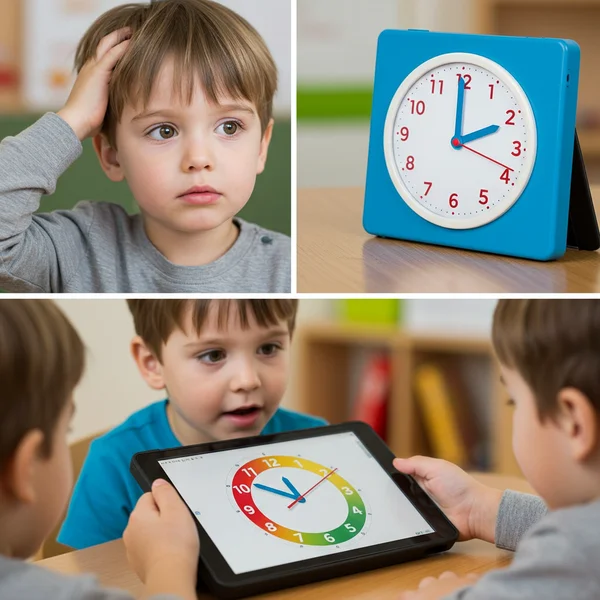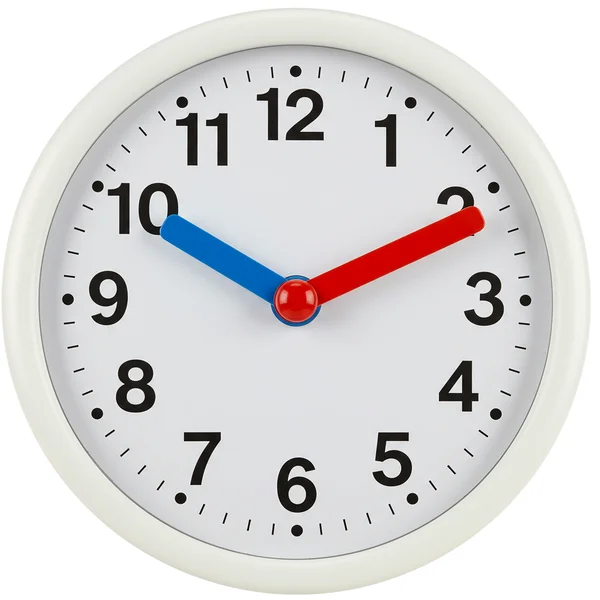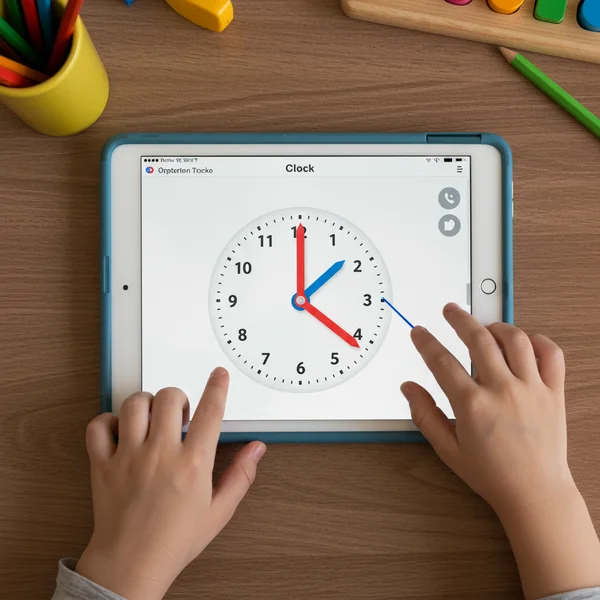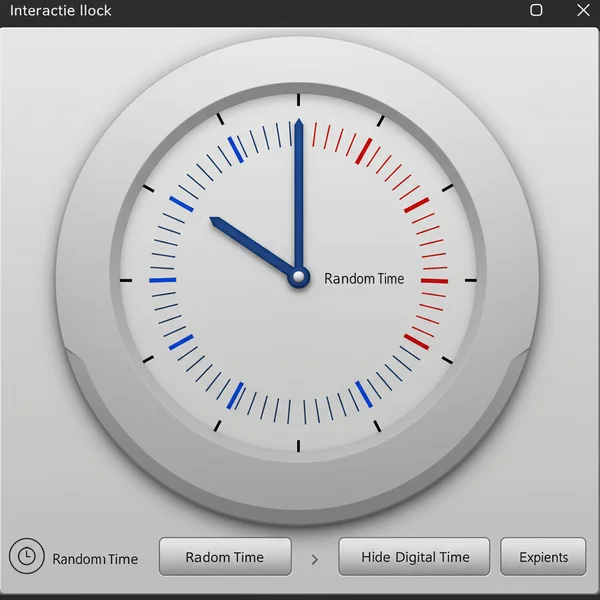Overcoming Analog Clock Struggles: Smart Strategies for Teaching Kids to Tell Time
Are you a parent or teacher watching a child struggle to learn the analog clock? You're not alone. The journey from staring blankly at a clock face to confidently announcing the time is filled with common hurdles. From confusing the long and short hands to grappling with the concept of minutes, these challenges can lead to frustration for everyone involved. But what if you could transform those time-telling tears into triumphs? How can you teach kids to tell time effectively and make the process enjoyable?
In this guide, we'll share practical, proven strategies to help your child overcome those common difficulties. We will explore why children get stuck and introduce effective teaching methods that turn learning into a game. With the right approach and interactive tools, you can build a strong foundation for time-telling skills. Let's dive in and discover how to make learning time with an interactive analog clock a fun and rewarding adventure.

Identifying Common Analog Time-Telling Hurdles for Kids
Before jumping to solutions, it's crucial to understand the specific kids telling time struggles. Recognizing these obstacles allows you to provide targeted support. Most children encounter the same few conceptual roadblocks on their path to mastering the analog clock. By pinpointing the exact issue, you'll know just how to help, preventing learning from feeling like a chore.
These hurdles are a normal part of the learning process. With patience and the right techniques, you can guide your child or students through them. Let’s break down the three most frequent challenges.
Confusing Hour & Minute Hands: The Blue and Red Distinction
One of the first and most significant challenges for a child is distinguishing between the hour and minute hands. They often mix them up, leading to incorrect time readings. A child might see 2:45 but read it as 9:10 because they swapped the functions of the short and long hands. This confusion is completely normal but requires a clear, visual way to differentiate them.
This is where visual aids become incredibly powerful. Our educational clock helps solve this by color-coding the hands: a short blue hand for the hour and a long red hand for the minutes. This simple visual cue helps children associate color with function, making it easier to explain the hour and minute hand. Consistently referring to "the little blue hour hand" and "the big red minute hand" creates a strong mental link that reduces confusion.

Grasping 5-Minute Increments & Counting Minutes
Once a child understands the hands, the next major hurdle is counting the minutes. The clock face is marked with numbers 1 through 12, but these same numbers represent minutes in increments of five. The abstract idea that the number "3" means "15 minutes" can be very confusing. Children often need a lot of practice to stop seeing the numbers at face value and start skip-counting by fives.
This is where teaching 5 minute intervals becomes a key focus. Repetitive, hands-on practice is the best way to solidify this skill. Allowing a child to physically move the minute hand from one number to the next while counting aloud ("5, 10, 15...") makes the abstract concept concrete. An interactive tool allows for endless repetition without the pressure of a worksheet, turning counting into an engaging activity.
The "To the Hour" vs. "Past the Hour" Conundrum
As children become more advanced, they face the challenge of reading time phrases like "quarter to" or "20 minutes past." Understanding why the hour hand isn't pointing directly at the "2" when the time is 2:45 requires a deeper understanding of how the hands move together. This concept of minutes to the hour can be tricky, as it involves both subtraction and relational thinking.
Explaining that the hour hand gradually moves from one number to the next as the minute hand completes its circle is key. Visually demonstrating this helps immensely. When you drag the minute hand on an online analog clock, the child can see the hour hand slowly creeping towards the next number. This live feedback makes the relationship between the hands clear and intuitive.
Proven Strategies for Effective Analog Clock Teaching
Now that we've identified the hurdles, let's focus on effective analog clock teaching strategies. The key to success is shifting from rote memorization to interactive, engaging experiences. A child who feels like they are playing is more motivated and absorbs information faster than a child who feels like they are being tested. These strategies are designed to be fun, intuitive, and highly effective for both parents at home and teachers in the classroom.
Make it Interactive & Hands-On with Digital Tools
Static images and worksheets can only go so far. Children learn best by doing. An interactive clock provides a hands-on experience that is essential for deep understanding. The ability to physically move the clock hands and see the digital time change instantly creates a powerful cause-and-effect learning loop. This active engagement is far more effective than passively watching someone else demonstrate.
Tools like the one on our homepage invite children into a "Fun Clock Playground." It transforms a learning task into one of the most effective fun timetelling games. They can drag the blue hour hand and red minute hand to discover how time works, turning abstract rules into tangible results. This hands-on exploration is fundamental to building a child's confidence and curiosity.

Breaking Down Time: Step-by-Step Learning for Children
Trying to teach everything about an analog clock at once is a recipe for overwhelm. Instead, follow a structured, step-by-step approach. Answering the question of how to read an analog clock step by step involves breaking it down into manageable parts. Start with the basics and build from there.
- Introduce the Hands: Begin by focusing only on the hour hand. Lock the minute hand and have the child set the hour.
- Learn the Hour: Practice telling time to the hour (e.g., 3:00, 4:00).
- Introduce the Minutes: Unlock the minute hand and explain its function. Practice skip-counting by fives.
- Combine the Skills: Start reading the full time, beginning with simple times like 3:15 or 4:30.
- Practice, Practice, Practice: Use a variety of telling time games and exercises to reinforce these skills.
Gamify the Learning Process: Boost Engagement & Fun
Turn learning into a game to keep children motivated. Gamification can be as simple as creating fun challenges or as structured as using a dedicated tool. The goal is to make practice feel less like work and more like play. This approach taps into a child's natural love for games and competition.
For example, you can say, "Let's set the clock to snack time!" or "Can you show me what 8:00 looks like? That's bedtime!" Using a tool with a "Random Time" feature allows you to create instant pop quizzes. This makes learning dynamic and exciting, perfectly aligning with the idea of a learning clock that is both educational and entertaining.
Maximizing Practice with an Interactive Clock
Consistent practice is what solidifies new skills. An adjustable clock with smart features provides endless opportunities for reinforcement. It allows for tailored exercises that target specific weaknesses, making practice sessions more efficient and effective. Here’s how you can leverage digital tools for mastery.
Utilizing Random Time Generation for Quick Quizzes
One of the best ways to build fluency is through rapid-fire practice. The "Random Time" button on our classroom clock practice tool is perfect for this. With a single click, the clock generates a new time, creating an instant quiz question. You can use this in the classroom on a smartboard for a group activity or at home for a quick one-on-one session.
To make it even more challenging, use the "Hide Digital Time" feature. The child reads the analog clock, says the time aloud, and then clicks "Show Digital Time" to check their answer. This immediate feedback loop is crucial for self-correction and builds independent learning habits.

Targeted Practice with Hand-Locking Features (Hour & Minute)
Is your child struggling specifically with the minute hand? Or maybe the hour hand's slow movement is the problem. Our focused time telling practice feature allows you to lock one hand in place while the child manipulates the other. This isolates the skill they need to work on, removing other distractions.
For instance, you can lock the hour hand at "3" and have the child practice moving the minute hand to show 3:10, 3:25, and 3:50. This targeted exercise helps them master a single concept before moving on. It’s a powerful feature that makes our interactive tool an indispensable resource for both parents and educators.
Your Child Can Master Time-Telling: The Interactive Solution Awaits
Teaching a child to read an analog clock doesn't have to be a struggle. By understanding common hurdles, applying smart strategies, and embracing interactive tools, you can make learning to tell time a positive and successful experience. The key is to make it hands-on, break it down into simple steps, and keep it fun.
You have the strategies, and the perfect tool is just a click away. Transform frustration into fun and watch your child's confidence soar. Ready to begin? Visit our fun clock playground and start exploring our free, interactive analog clock today!
Common Questions About Teaching Analog Clocks
Why are analog clocks still taught in school?
Analog clocks are still taught because they help children develop crucial cognitive skills. Reading an analog clock requires understanding fractions (quarters, half-past), skip-counting, and spatial reasoning. It provides a visual representation of the passage of time, helping children better grasp concepts like "before," "after," and duration in a way digital clocks do not.
What age should a child be able to read an analog clock?
Most children begin learning to tell time between the ages of 6 and 8. Typically, they can tell time to the hour and half-hour by age 6 or 7, and master time to the nearest five minutes and then to the minute by age 8. However, every child learns at their own pace, and using engaging telling time games can make the process smoother regardless of age.
How do you explain the hour and minute hand to a child?
A great way is to use size and color associations. Explain that the "hour" is a shorter word, so it has the short hand (our blue one). "Minute" is a longer word, so it gets the long hand (our red one). Using a hands-on tool like our educational clock where they can move each hand individually reinforces this distinction visually and physically.
Are analog clocks better for learning time?
Yes, for initial learning, analog clocks are generally considered better. They provide a visual, spatial context for time that helps children understand its cyclical nature and the relationship between hours and minutes. Once a child masters the analog clock, reading a digital one is effortless. An interactive clock combines the best of both worlds, showing the analog face and the digital readout simultaneously for a comprehensive learning experience.